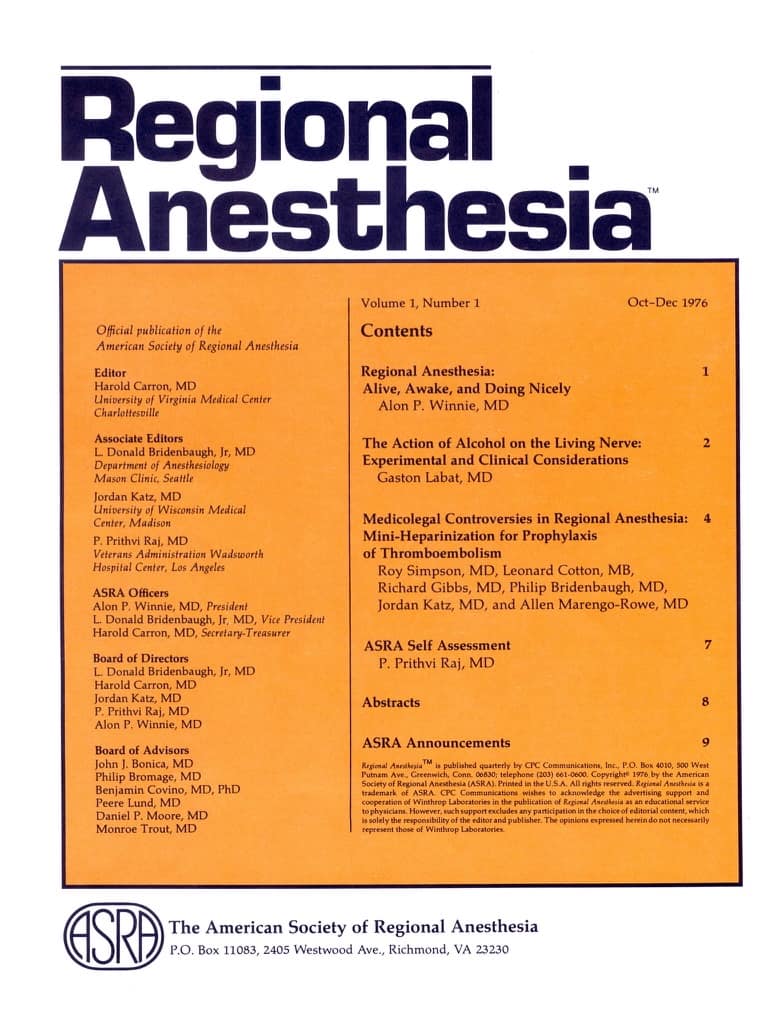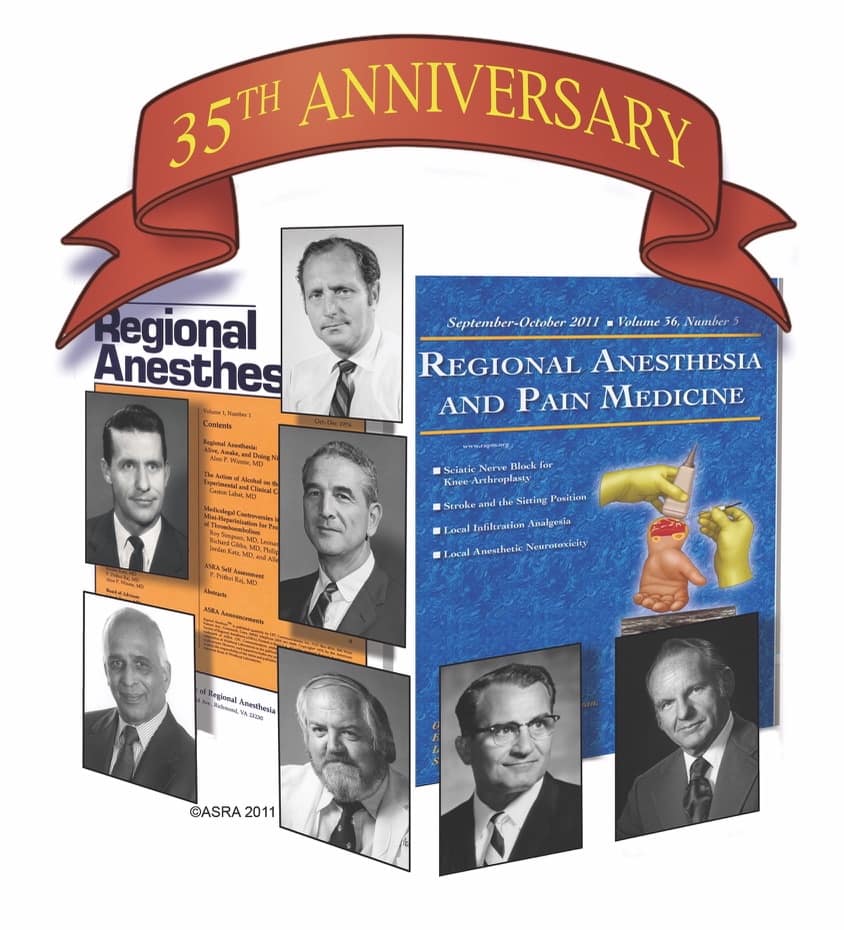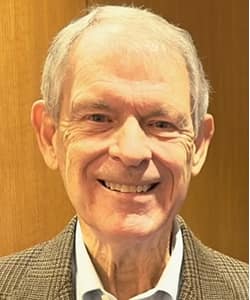From Rag to Riches: The Early Years of Regional Anesthesia and Pain Medicine
Cite as: Neal JM. From rag to riches: the early years of Regional Anesthesia and Pain Medicine. ASRA Pain Medicine News 2025;50. https://doi.org/10.52211/asra020125.004.
Some of you may recall holding a paper copy of Regional Anesthesia and Pain Medicine (RAPM) in your hands before electronic publication deprived you of that musty, dog-eared, yellow-highlighted, beverage-spilled pleasure. Many fewer of you have ever held a copy of Volume 1, Issue 1 (Figure 1), which began as a humble rag of a bulletin and metamorphosed into the highly respected and cited subspecialty journal that you know today as RAPM. What were RAPM’s early beginnings, and if they were to happen today, would ASRA Pain Medicine even have a journal to call its own?

As we celebrate the 50th anniversary of ASRA Pain Medicine’s second founding, the story of the subsequent birth of its journal is worth telling. Many of you know the story of the American Society of Regional Anesthesia’s first founding in 1923 by Gaston Labat, followed by its dissolution in 1940 as general anesthetic agents improved, interest in regional anesthesia waned, and the newly formed American Society of Anesthesiologists (ASA) sought to become our specialty’s dominant professional organization. Doug Bacon1 has described the Frenchmen Gaston Labat and his mentor Victor Pauchet as the first generation of regional anesthetists. The second generation of pioneers – Seattle rivals Dan Moore and John Bonica – managed to keep regional anesthesia and obstetric anesthesia/pain medicine, respectively, alive over the ensuing decades. Spurred by Moore and Bonica’s leadership and academic output, a progression of innovation and clinical indications led to ASRA’s second birth. The third generation, also known as the “Founding Fathers” (Don Bridenbaugh, Harold Carron, Jordan Katz, Prithvi Raj, and Alon Winnie), discussed ASRA’s reformation in late 1974 and held its first meeting in July 1975.2 Guided by the vision of Harold Carron, who would become its first editor, the founders foresaw the importance of establishing a journal if the new society were to garner academic credibility. Consequently, Regional Anesthesia Volume 1, Issue 1 was published October–December 1976. On the 35th anniversary of that beginning, the cover of RAPM’s September-October 2011 issue duly honored the five founding fathers, as well as Moore and Bonica, for making it all happen.3 (Figure 2)

What was the neonatal RAPM like? The original version, simply named Regional Anesthesia, began as a 10-page non-indexed bulletin distributed free of charge to ASRA and ASA members. It contained “How I Do It” articles (read: “Only I know the proper way to do this block.”), non-editorial commentary, society announcements, a self-assessment quiz, and a few original articles. However, there were complicating factors related to Regional Anesthesia’s initial volumes, at least as viewed through today’s lens. Winthrop Laboratories, a purveyor of anesthetic agents, entirely underwrote the early years of publication. Winthrop’s vice president, Monroe Trout, MD, and Ben Covino, MD, PhD (vice president for scientific affairs of Astra Pharmaceuticals, a major manufacturer of local anesthetics) comprised two of six members of ASRA’s advisory board, which subserved the board of directors. By 1978, Abbott Laboratories supplanted Winthrop as the journal’s major financial sponsor. Perhaps understandably for a young society, the Journal's three associate editors were ASRA board members who, in turn, authored three of the journal’s first four articles. When the number of associate editors increased to five in 1978, all had a connection to Seattle. The new journal printed no editorials related to its content but rather commentaries in which directors and editors opined on topics important to themselves. Although I have never found documentation of peer review during these early years, if it existed, it likely did so in a nepotistic chamber of director-editors, who largely published their own work. Please understand that none of the above history is intended to impugn Regional Anesthesia’s original editorial structure or its almost certain necessity for financial support. Instead, I mean to highlight a juxtaposition of norms separated by a half-century. It is unlikely that today’s Regional Anesthesia and Pain Medicine would exist were it not for the ethical norms of the late 1970s that facilitated the birth and growth of Regional Anesthesia. Conversely, it is certain that if adjudicated by contemporary publication ethics, adhering to the norms of 1976 would veto the journal’s founding today.
What was the neonatal RAPM like? The original version, simply named Regional Anesthesia, began as a 10-page non-indexed bulletin distributed free of charge to ASRA Pain Medicine and ASA members.
Despite its inauspicious beginnings, Regional Anesthesia grew quickly and gained importance. For instance, a 1977 animal study was one of, if not the first, to report the analgesic effects of neuraxial opioids. By 1978, Regional Anesthesia was circulated to nearly 1,500 ASRA members in 16 countries.3 In 1981, the board of directors realized the practical limitations of the conflicts of interest inherent to society/pharmaceutical company relations. Consequently, the board voted to abandon the industry-sponsored, closed circulation, free-of-charge model for paid subscriptions to an independent journal.2 Doing so quickly allowed Regional Anesthesia to become indexed, and it increasingly took on the look of a scientific publication. Names of board members and advisors no longer populated the masthead but rather a growing cadre of national and international academic consulting editors. Non-editorial commentaries and “How I Do It” yielded to peer-reviewed original articles and case reports. Although it would remain a quarterly publication for several more years, by 1981, the journal was printing nearly 200 pages a year. This chronicles the first five years of Regional Anesthesia, the quarterly non-indexed society bulletin that would become one of the premier scientific tomes of anesthesiology and pain medicine. The circumstances of its birth could not happen today. Nevertheless, we must admire the perseverance of the founding fathers’ closed-shop approach to growing a fledgling publication and their pharmaceutical industry partners who bankrolled the enterprise.
In brief, the next 30 years were highlighted by the Journal's rapid growth and scientific impact. In 1986, the journal began its first affiliation with ASRA Pain Medicine sister societies, beginning with the European Society of Regional Anaesthesia. Regional Anesthesia became a bimonthly publication in 1989; monthly publication would follow in the mid-2010s when Marc Huntoon became editor-in-chief. The journal was publishing over 600 pages per year by the mid-1990s. Its five-year impact factor always placed it in the top 10 anesthesiology and pain journals and frequently in the top five. Such recognition was linked to sentinel publications like one of the first descriptions of ultrasound-guided nerve block in 1992 and ASRA’s first practice advisory (1998) on anticoagulation and concurrent neuraxial blockade. Led by pain physician editors-in-chief Philip Bridenbaugh and David Brown, the journal steadily increased its publication of acute and chronic pain medicine manuscripts. Consequently, the journal changed its name to Regional Anesthesia and Pain Medicine in 1998, 22 years after the publication of Regional Anesthesia Volume 1, Issue 1 .

References
- Bacon DR. The next generation. Reg Anesth Pain Med 2011;36:527-8. https://doi.org/10.1097/AAP.0b013e318232e96d
- Winnie AP. The Diary of a Dream: the American Society of Regional Anesthesia (for surgery, obstetrics, and pain control). Reg Anesth Pain Med 2006;31:569-74. https://doi.org/10.1016/j.rapm.2006.09.003
- Neal JM, Baker J. Regional Anesthesia, and Pain Medicine after 30 years: A historical perspective. Reg Anesth Pain Med 2006;31:575-81. https://doi.org/10.1016/j.rapm.2006.09.004
- Neal JM. Regional Anesthesia and Pain Medicine: Thirty-five years old, thanks to 5 (make that 7) amazing individuals. Reg Anesth Pain Med 2011;36:529-30.